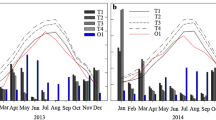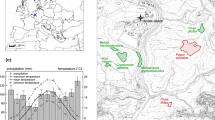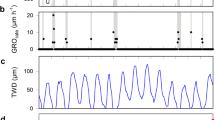Summary
A computer model predicted the minimum stem surface temperature, which generally occurred at the apex, for various species of cacti under a particular set of environmental conditions. Based on stem mass, spines, and apical pubescence for the four Ferocactus species found in the southwestern United States, F. acanthodes had the highest minimum apical temperatures and hence was predicted to range the furthest north, F. wizlizenii next, then F. covillei, and finally F. viridescens, in agreement with field observations. Direct measurement of apical temperatures at night showed that F. viridescens was about 2°C colder than a side-by-side F. acanthodes, in agreement with the model. The simulated apical temperature of Trichocereus chilensis increased about 0.3°C for each 50 cm increase in height up to 2 m; observations at a high elevation site in central Chile showed that the freezing damage progressively halved over this sequence of height intervals. The upper elevational limit of Eriosyce ceratistes and T. chilensis at different latitudes from 29°S to 35°S indicated that the populations were responsive to changes of only 0.1°C. Such temperature sensitivities underscore the importance of morphological differences in establishing the low temperature limits on the ranges of cacti in particular and plants in general.
Similar content being viewed by others
References
Backeberg C (1966) Das Kakteenlexikon, Gustav Fischer Verlag, Jena
Benson L (1969a) The Cacti of Arizona, 3rd ed. (revised). The University of Arizona Press, Tucson
Benson L (1969b) The Native Cacti of California. Stanford University Press, Stanford
Hajek ER, di Castri F (1975) Bioclimatografía de Chile. Universidad Católica de Chile, Santiago
Lewis DA, Nobel PS (1977) Themal energy exchange model and water loss of a barrel cactus, Ferocactus acanthodes. Plant Physiol 60:609–616
Nobel PS (1978) Surface temperatures of cacti — Influences of environmental and morphological factors. Ecology 59:986–996
Nobel PS (1980a) Morphology, surface temperatures, and northern limits of columnar cacti in the Sonoran desert. Ecology 61:1–7
Nobel PS (1980b) Morphology, nurse plants, and minimum apical temperatures for young Carnegiea gigantea. Bot Gaz in press
Shreve F (1911) The influence of low temperature on the distribution of the giant cactus. Plant World 14:136–146
Shreve F, Wiggins IL (1964) Vegetation and Flora of the Sonoran Desert, Volume II. Stanford University Press, Palo Alto
Steenbergh WF, Lowe CH (1976) Ecology of the saguaro: I. The role of freezing weather in a warm-desert plant population, In: Research in the Parks, National Park Service Symposium Series, No 1, US Government Printing Office, Washington DC, p 49–92
Steenbergh WF, Lowe CH (1977) Ecology of the Saguaro: II. Reproduction, germination, establishment, growth, and survival of the young plant, In: National Park Service Scientific Monograph Series, No. 8, U.S. Government Printing Office, Washington, DC p 1–242
Turnage WV, Hinckley AL (1938) Freezing weather in relation to plant distribution in the Sonoran desert. Ecol Monogr 8:529–550
Author information
Authors and Affiliations
Rights and permissions
About this article
Cite this article
Nobel, P.S. Influences of minimum stem temperatures on ranges of cacti in southwestern United States and central Chile. Oecologia 47, 10–15 (1980). https://doi.org/10.1007/BF00541769
Received:
Issue Date:
DOI: https://doi.org/10.1007/BF00541769




